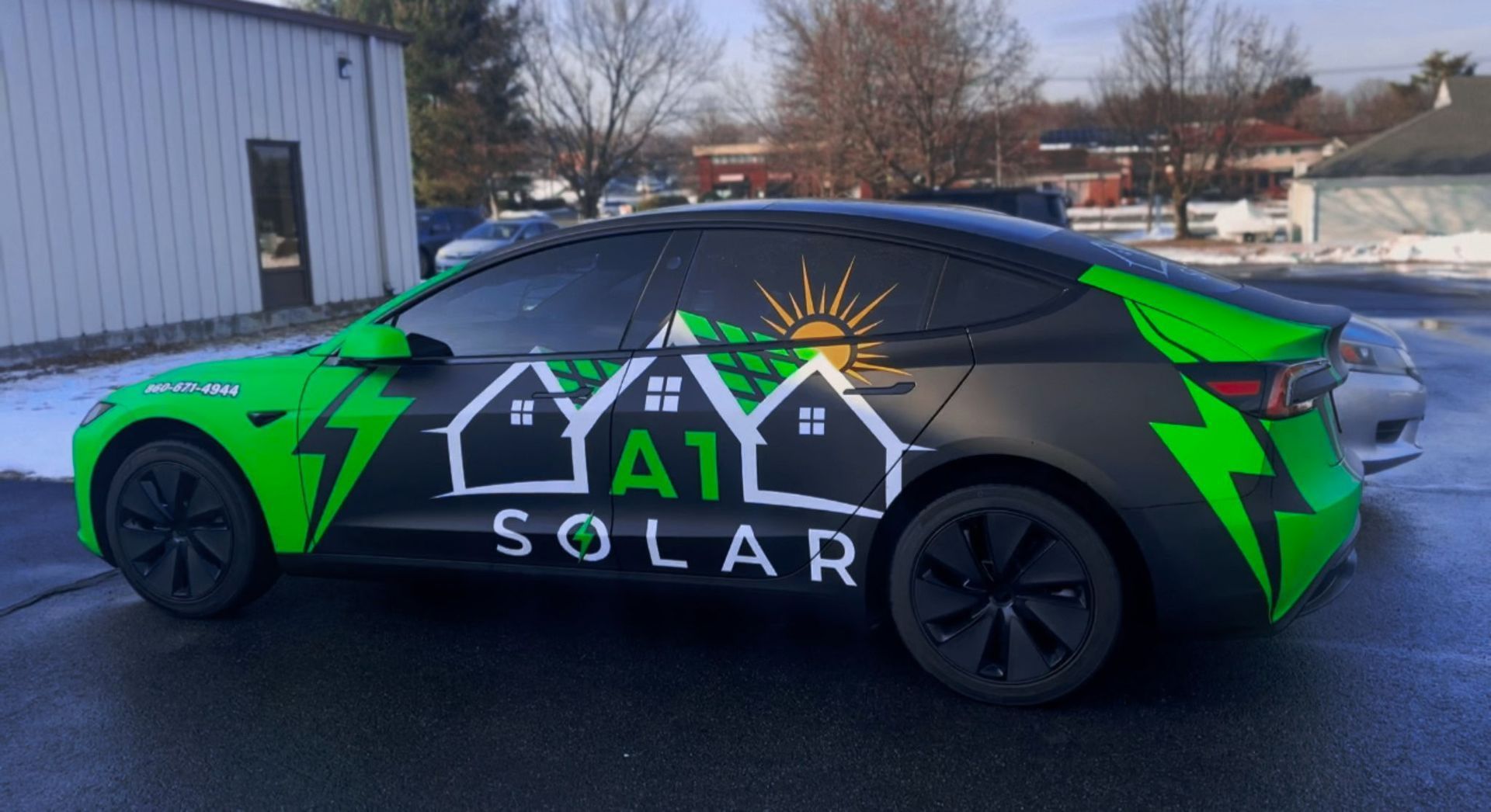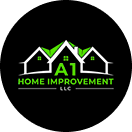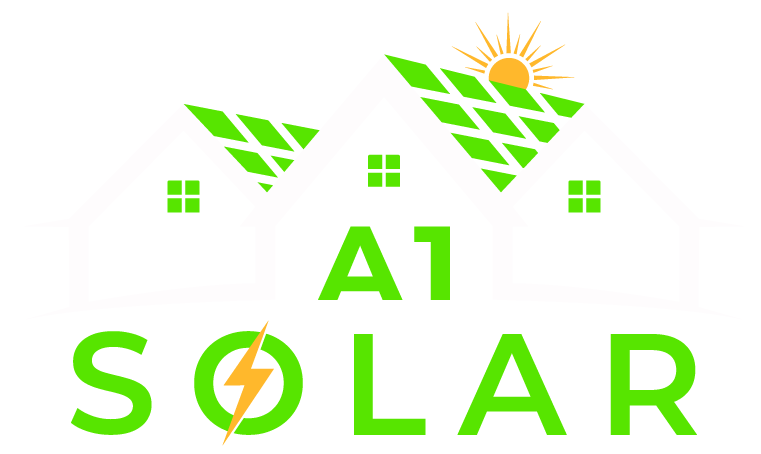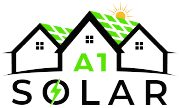FAQs
At A1 Solar, we understand that switching to solar energy is a big decision, and you probably have a lot of questions. That’s why we’ve put together this comprehensive FAQ section to address the most common inquiries about solar panels, installation, costs, and benefits.
Book a Free Consultation

Solar Panel Basics
How do solar panels work?
Solar panels convert sunlight into electricity using photovoltaic (PV) cells. When sunlight hits the panels, it generates direct current (DC) electricity, which is then converted into usable alternating current (AC) electricity through an inverter. This power can be used to run your home or business, with any excess energy stored in batteries or sent back to the grid.
What are solar panels made of?
Most solar panels are made from silicon-based photovoltaic (PV) cells, encased in tempered glass for durability. They also include an aluminum frame and a backsheet to protect the internal components. There are different types of solar panels, including monocrystalline, polycrystalline, and thin-film, each with varying efficiency and performance levels.
Do solar panels work on cloudy days or at night?
Solar panels generate electricity during daylight hours, but their efficiency decreases on cloudy or rainy days. However, they can still produce some power in indirect sunlight. At night, solar panels do not generate electricity, but homes with battery storage or net metering can use stored energy or draw from the grid when needed.
How long do solar panels last?
Most high-quality solar panels have a lifespan of 25 to 30 years or more. While their efficiency gradually decreases over time, they can still generate electricity well beyond their warranty period. Proper maintenance and cleaning can help maximize their performance and longevity.
What is the difference between monocrystalline and polycrystalline solar panels?
Monocrystalline solar panels are made from a single crystal structure, making them more efficient and space-efficient, but typically more expensive. Polycrystalline panels are made from multiple silicon fragments, making them slightly less efficient but more affordable. Both options are effective for residential and commercial solar systems, depending on your budget and energy needs.
Solar Installation
How long does it take to install solar panels?
The actual installation of solar panels typically takes 1 to 3 days, depending on the size and complexity of the system. However, the entire process—including site assessment, permitting, utility approvals, and inspections—can take anywhere from 4 to 8 weeks, depending on your location and local regulations.
What is the process for installing solar panels?
The installation process generally involves:
- Site Assessment – A professional evaluates your roof’s condition, sun exposure, and energy needs.
- System Design & Permitting – Engineers design your system, and necessary permits are obtained.
- Installation – Solar panels, inverters, and electrical wiring are installed.
- Inspection & Approval – Local authorities and utility companies inspect the system before granting permission to operate (PTO).
- System Activation – Once approved, your solar system is turned on and starts producing energy.
Will solar panels damage my roof?
No, when installed correctly by a professional, solar panels will not damage your roof. In fact, they can help protect the covered areas from weather exposure. Installers use specialized mounting equipment and sealing techniques to ensure the integrity of your roof. If your roof needs repairs, it’s best to address them before installation.
Do I need to replace my roof before installing solar panels?
If your roof is in good condition and has at least 10–15 years of life left, you likely won’t need a replacement before installing solar panels. However, if your roof is aging or has significant damage, it’s best to replace it before installation to avoid the cost and hassle of removing and reinstalling panels later.
Can I install solar panels myself, or do I need a professional?
While DIY solar kits exist, installing solar panels requires electrical expertise, structural knowledge, and compliance with local building codes. Professional installation ensures safety, efficiency, and eligibility for warranties, tax credits, and net metering programs. Hiring a certified solar installer is the best way to maximize your system’s performance and long-term reliability.
Personal Benefits
How much can I save on my electricity bills with solar panels?
The amount you save depends on factors like your energy consumption, local electricity rates, and the size of your solar system. On average, homeowners can reduce their electricity bills by 50% to 100%, with some even eliminating their utility costs entirely through net metering or battery storage.
Will solar panels increase my home’s value?
Yes! Homes with solar panels typically sell faster and at a higher price. Studies show that solar installations can increase home values by 4% to 10%, making it a great long-term investment. Buyers are often willing to pay more for energy-efficient homes with lower electricity costs.
Can I get tax credits or incentives for installing solar panels?
Yes! The federal Investment Tax Credit (ITC) allows homeowners to deduct 30% of their solar installation costs from their federal taxes. Many states and local governments also offer additional rebates, incentives, and net metering programs that further reduce costs. Check with your local solar provider for available incentives in your area.
How do solar panels benefit the environment?
Solar energy is a clean, renewable source of power that reduces carbon emissions and dependence on fossil fuels. By switching to solar, you help lower greenhouse gas emissions, decrease air pollution, and promote sustainability for future generations.
Can I go completely off-grid with solar panels?
Yes, but it requires a properly sized solar system with battery storage. Most homeowners stay connected to the grid for backup power, but with sufficient battery capacity, you can generate and store enough energy to power your home independently. This is especially beneficial in areas with frequent power outages or remote locations without grid access.
Solar & Electric Vehicle Charging
Can I charge my electric vehicle (EV) with solar panels?
Yes! Solar panels can generate electricity to charge your EV, reducing or even eliminating your reliance on the grid. By pairing your solar system with an EV charger, you can power your car with clean, renewable energy and lower your charging costs.
How many solar panels do I need to charge an EV?
The number of panels needed depends on your EV’s battery size, driving habits, and solar panel efficiency. On average, an EV requires 4 to 10 solar panels to fully charge daily. For example, a Tesla Model 3 with a 50 kWh battery would need about 7–10 panels to cover its charging needs.
Do I need a special charger to use solar power for my EV?
You’ll need a Level 2 EV charger for faster, more efficient charging. Some chargers are solar-compatible, allowing direct integration with your solar system. You can also use a standard grid-connected EV charger and offset the electricity used with your solar energy production.
Can I charge my EV at night with solar power?
Since solar panels only produce electricity during the day, you’ll need battery storage to charge your EV at night. A home battery, like the Tesla Powerwall or Enphase IQ Battery, stores excess solar energy generated during the day, allowing you to charge your EV even after the sun goes down.
Is it cheaper to charge an EV with solar panels than using the grid?
Yes! Charging an EV with solar power significantly reduces your electricity costs compared to grid charging. With solar, you can avoid rising utility rates and take advantage of free, renewable energy. Over time, this leads to substantial savings on fuel and electricity costs.
Environmental Impacts and Benefits
How do solar panels help reduce carbon emissions?
Solar panels generate electricity from the sun, eliminating the need for fossil fuels like coal, oil, and natural gas. By switching to solar energy, you reduce your carbon footprint and help decrease greenhouse gas emissions, which contribute to climate change. On average, a home solar system can offset 3 to 4 tons of carbon dioxide per year—equivalent to planting over 100 trees annually!
Is solar energy truly a renewable resource?
Is solar energy truly a renewable resource? Yes! Unlike fossil fuels, which are finite and take millions of years to form, solar energy is 100% renewable. The sun provides an inexhaustible source of energy that can be harnessed daily, making it one of the most sustainable power solutions available.
Do solar panels cause pollution during production?
The production of solar panels does require raw materials and energy, which can create some emissions. However, solar panels offset their manufacturing emissions within 1 to 3 years of use, after which they provide decades of clean energy. Compared to fossil fuel power plants, solar has a significantly lower environmental impact over its lifespan.
What happens to solar panels at the end of their lifespan?
Solar panels typically last 25 to 30 years, and many components can be recycled. Recycling programs recover valuable materials like silicon, glass, and aluminum, reducing waste and environmental impact. As solar adoption grows, recycling technology continues to improve, making solar energy even more sustainable.
Does installing solar panels harm local wildlife?
No, rooftop solar panels have no negative impact on wildlife. In fact, they help protect the environment by reducing reliance on fossil fuels, which contribute to habitat destruction, air pollution, and climate change. For ground-mounted solar farms, responsible site planning ensures minimal disruption to ecosystems and local biodiversity.
For more information about our services or to schedule an appointment, call us at (860) 671-4944 or complete the form below we’ll get back to you as soon as we can.




ABOUT US
Trusted Expertise, Now in Solar
For over 35 years, A1 Home Improvement has been Connecticut’s go-to roofing expert. Now, we’re bringing that same trusted service and craftsmanship to solar with A1 Solar. As a company built on quality, reliability, and customer satisfaction, we’re here to make switching to solar simple, seamless, and stress-free.
Backed by decades of roofing experience, we know how to design and install solar systems that maximize efficiency while protecting your home. When you choose A1 Solar, you’re choosing a team that understands every aspect of your roof and energy needs—so you can invest in solar with confidence.
Take control of your energy bills
Ditch high electricity costs and make the switch to solar today.
Shout out to A1 home improvement, they did a fantastic job on siding our house and replacing our back door and storm door, adding a new bow window, beautiful , We love the color, it looks like a new house!
For more information about our services or to schedule an appointment, call us at (860) 671-4944 or complete the form below we’ll get back to you as soon as we can.

At A1 Solar, we’re passionate about transforming Connecticut homes and businesses with sustainable energy solutions. Our experienced team blends industry expertise and innovative approaches, ensuring you receive reliable and affordable solar installations that light up your life—while putting the planet first. Let’s go green together!
Quick Links
All Rights Reserved | A1 Solar
